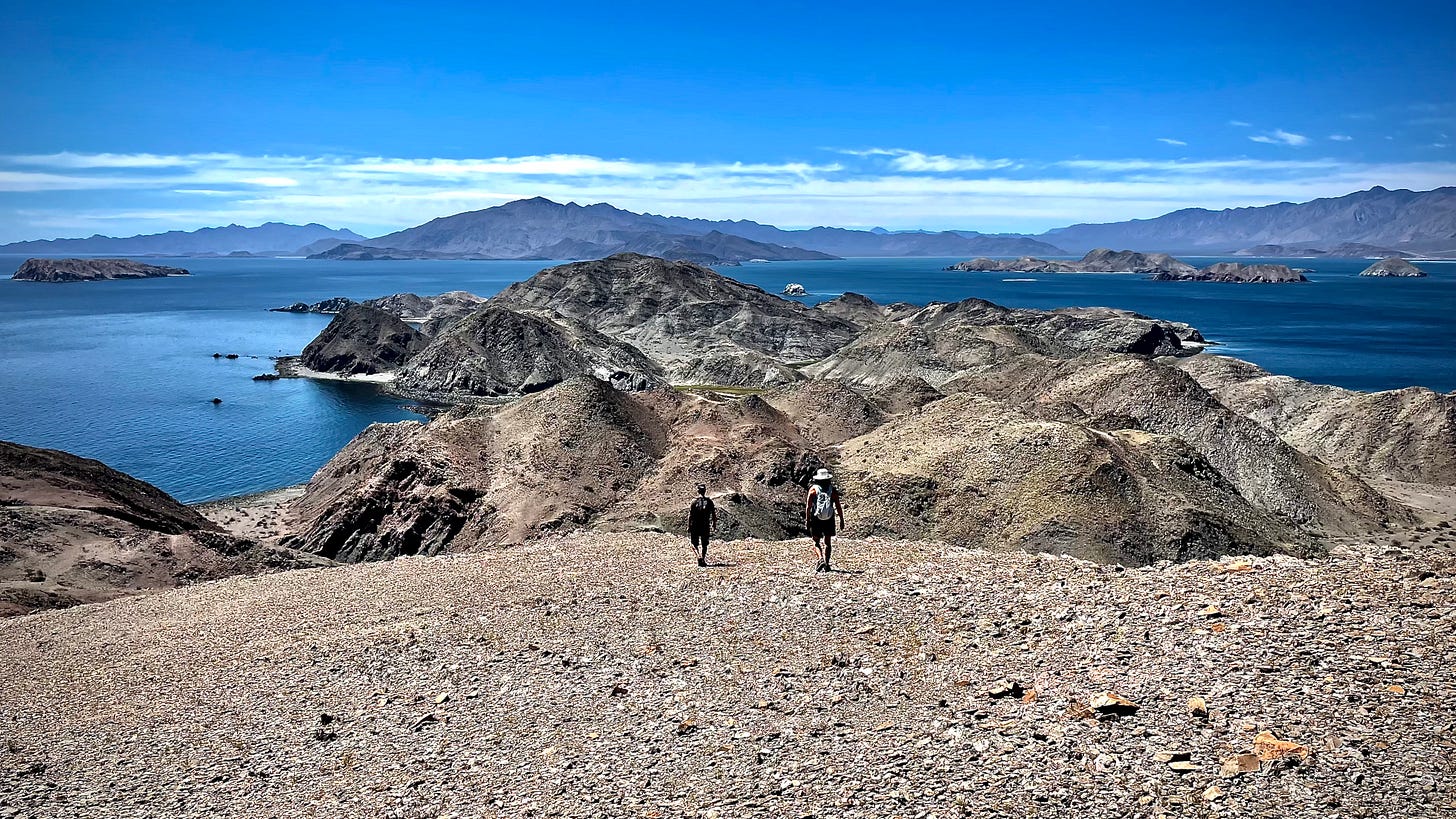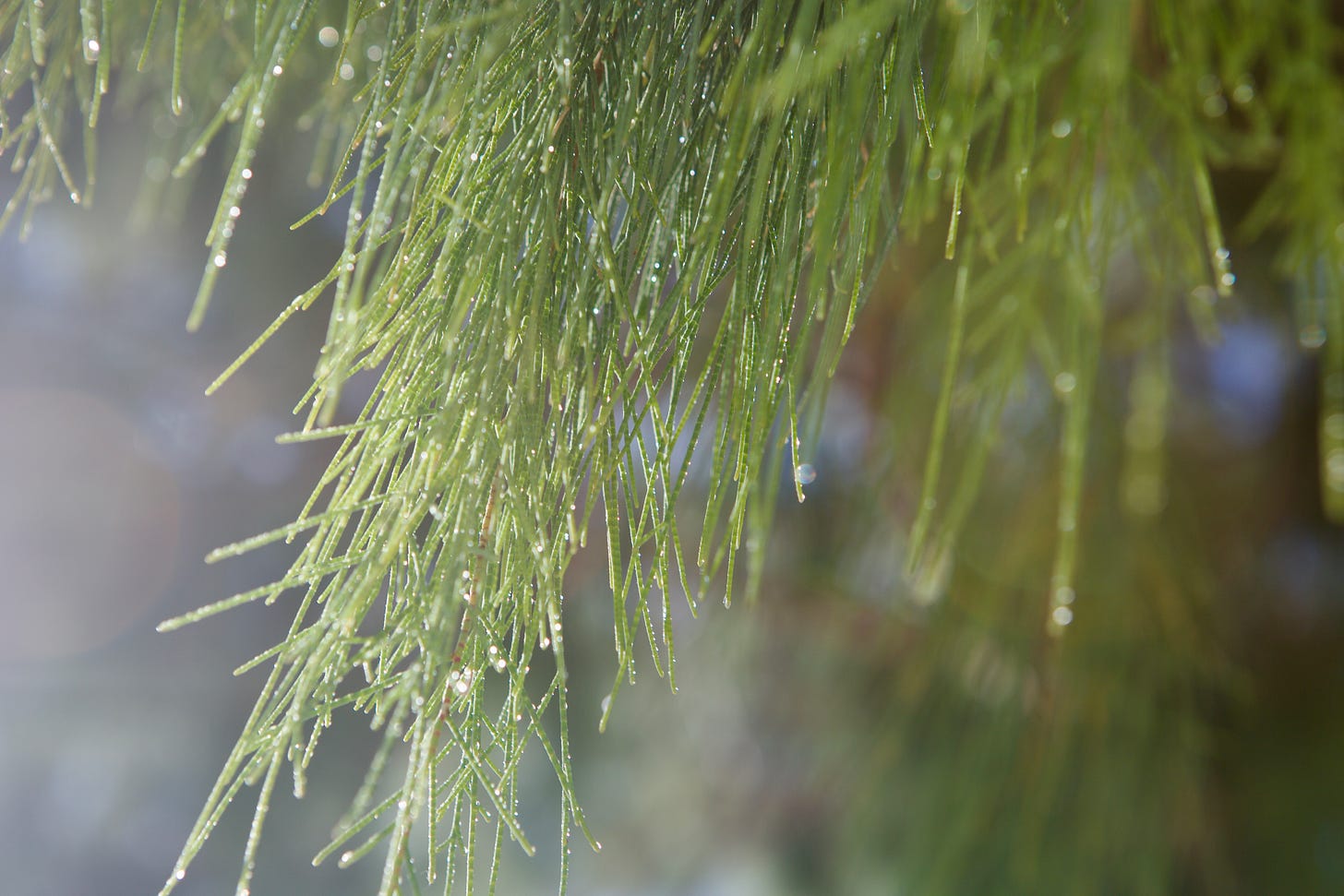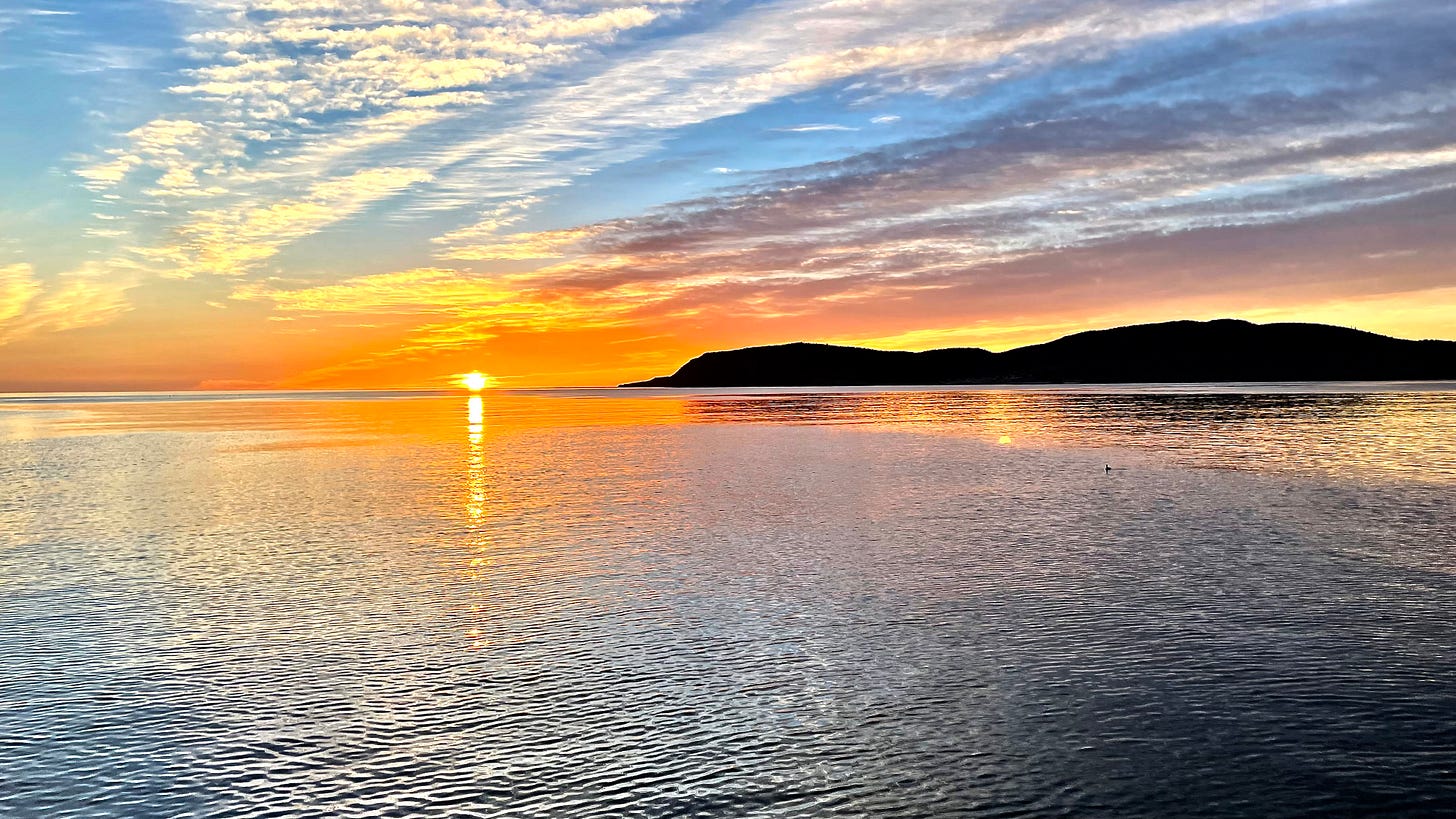Crossing to the Mainland
Sailing to Bahia San Pedro
As we reached Isla Smiths and the Coronado volcano, and for the week or so before, we were becoming increasingly aware that our time in the Sea of Cortez was drawing to a close. We had reached the furthest northern point for our voyage, and would turn around to start retracing our path south to the point where we’d strike out across the width of the sea for the Mexican mainland.
Our first stop on the trip south was to Ensenada el Quemado. After leaving in the morning, we dropped anchor around midday, giving us enough time for an afternoon hike. Quemada is separated from the next bay down the coast, el Pescador, by a fairly narrow isthmus, so we walked across to check out the beach on the far side.
The isthmus was typical Baja scrub. Scattered desert plants amid a flat sandy and stony plain, with splashes of red where plants were opening their tiny flowers in the arid afternoon sun. As we approached the far side, the desert was scattered with the detritus of a failed resort that had been built on the beach at el Pescador. A commercial Wolf gas range, a large genset in chipped green paint etched with “Lister Dursley England,” a trailer sized generator, and plastic agricultural water tanks stood out amidst the various signs of civilization decaying into the desert.
The resort consisted of a row of buildings spread along the beach, ranging from a couple of very nice houses with glass sliding doors fronting the ocean, clean and tidy inside, locked, waiting for their occupants to return at any moment, to a couple of large, thatched palapas built on wooden columns grown as pairs of twisting vines like some vegetal version of the columns of St. Peter’s cathedral. Some of these looked as if they started their slide into ruin before being completed, with plumbing half installed.
Among the buildings stood whale bones, bleached in the sun, little mushroom shaped thatched umbrellas, and a few curious trees. These had long, hanging branches, covered in feathery leaves glistening and dripping in the sun. Somehow, these trees seemed to be pulling water up out of the beach, and exuding this moisture among the leaves. As the afternoon shadows grew longer, we slowly walked back across to our own beach, among the discarded, desiccated skeletons of trigger fish, long since filleted and picked over by the gulls.
The next day was a longer sail back over to San Francisquito. Our last visit had been exceedingly brief, only an overnight stop, and this time we wanted to spend at least a little time to explore. Our first morning, we woke and headed out for a hike first thing in the morning, heading up one of the arroyos to the ridge behind the beach, then crossing over into a separate arroyo and walking back down to the beach, and across to where we started.
The geology in the area was interesting, with conglomerate and sandstone sculpted by the wind into large windswept cliffs, and caves filled the footprints of the coyotes that had take refuge there. The ridge was fairly high — several hundred feet at least — and the views as we turned back towards the water were full of blue and yellow, with the smallness of our boats in the distance reinforcing the remoteness of the area. From the top of the ridge, the land around was empty desert, ridge after ridge into the distance.
Walking back, we ran across a large cordone cactus, the ends of its branching arms covered in its peculiar flowers. Long and thin, with the delicate white flower opening at the end, bees buzzed about, crawling inside to drink their fill. Nearby, another of these ancient cactus (they take hundreds of years to grow) had spent its years and was slowly crumbling back into the earth.

After the hike, Scott from Fundango and I did a little reconnaissance of the shallow area on the south side of the bay. As we cruised along in his little dinghy, we watched as a pod of humpback whales surfaced, blowing, before submerging, sometimes lifting the flukes of their massive tails into the air as they slipped below the calm surface.
In the afternoon, we all dinghied over to the other side of the bay, walked through the tiny settlement of Playa San Franciquito, down the road, and across a dirt airstrip to a small group of concrete houses on the opposite shore, where we had heard there was a restaurant. A woman pouring buckets of water into a washing machine on the porch behind one of the houses, looking up as we approached. “Si, el restaurante esta enfrente,” she said, gesturing to the porch on the other side of the house. After our tacos and cold cervezas, we walked back, avoiding the muddy road in front of the washing machine, to rest up before leaving for the mainland early in the morning.
At about three AM, we all woke, started our engines, turned on our navigation lights, picked up our anchors, and headed out of the bay to start the long passage across the Sea, so that we would arrive before sunset, and wouldn’t have to enter a strange bay and anchor in the dark.
The crossing itself was excellent, with wind the entire way, and mostly on the quarter — that is, coming from behind and to the side. From the anchorage, Fundango headed more truly east with us, as Rochambeau headed a bit further south, trying to pick up a better angle to our final destination. As the day wore on, we all slowly converged onto the same line.
For hours we sailed along at ten and eleven knots, and almost never dropped below seven. The sea state was very calm through most of the day, only picking up in the afternoon as we approached Bahia San Pedro. We didn’t see another boat all day, except for two large shrimp boats, one overtaking us, and the other crossing from the far side, both of which passed within about fifty meters, one on each side, at the same time.
As the sea state built late in the afternoon, driven by the steady winds blowing all day, our route started trending further south and downwind. As the wind started easing a bit, with our nearly downwind course, we decided to start the engines and motor sail the last hour or so.
We were pretty tired by the time we dropped anchor. Talking about the trip afterwards, we realized that despite our very early start, neither of us had really taken much time off, resting below, since we were sailing through the day. As a result, we both ended up much more tired than we would have been if we had kept to a stricter watch schedule, each of us resting below off-watch.
Our new harbor, San Pedro, was a welcome calm after the rougher seas during the last hours of our passage. We were tucked up behind the headland, which protected us from the swell. John and Marcie hosted everyone for sun-downers and dinner to celebrate the crossing, and before long, everyone was ready to climb into their berths, as cruiser midnight (nine o’clock) was swift approaching.














Well, I'm all caught up! Great reading and photos! And, I'm finally getting the emails in the primary tab of my inbox! Smooth sailing going forward.
You are like naturalists and archeologists, exploring foreign lands. Thanks for bringing us along.